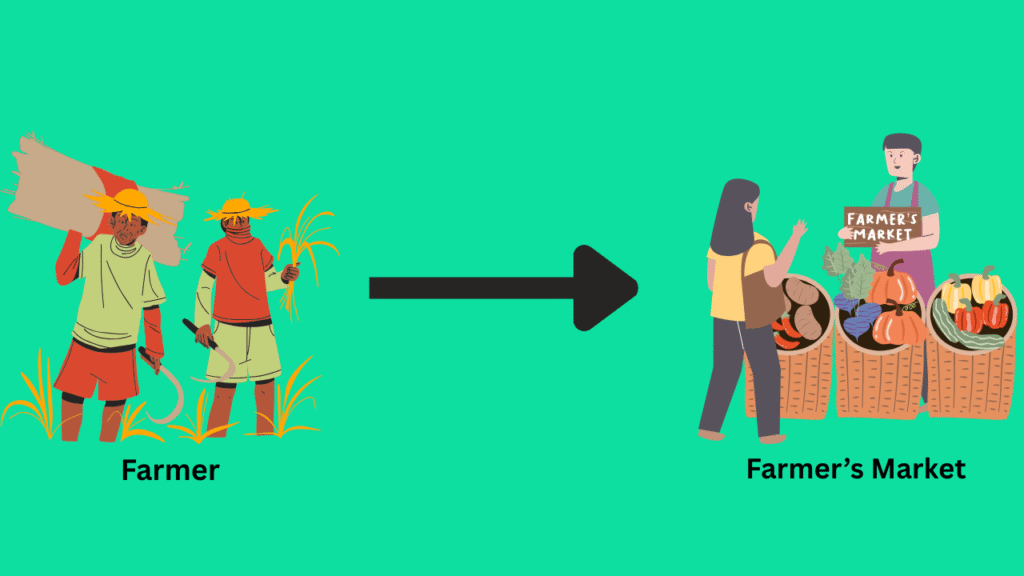In India, most farmers depend on middlemen and mandis to sell their produce. While this system helps in bulk selling, it often leaves farmers with low profit margins. The consumer pays a high price, but the farmer receives only a small portion of it.
The good news is: farmers today have multiple direct-to-customer (D2C) options. By cutting out middlemen, farmers can earn better profits, build long-term customers, and create a stable source of income.
Here are 8 smart ways farmer can sell their produce directly to customers:

1. Local Farmer Market (Weekly Bazaar)
- Setting up a stall in local farmer markets allows direct interaction with consumers.
- Customers trust fresh, local produce over long-stored market vegetables.
- Even small farmers can sell their seasonal crops directly.
👉 Tip: Use a clean, attractive stall and display prices clearly to win customers’ trust.
There are ways, you can sell farm produce outside of your farm. If farm is road touch or there are more footfall.
2. Tie-up with Restaurants & Hotels
- Many restaurants and hotels prefer farm-fresh vegetables, fruits, dairy, and grains.
- Direct supply contracts can ensure steady income for farmers.
- Organic or chemical-free produce can fetch premium prices.
👉 Example: Supplying coriander, spinach, or tomatoes directly to a hotel on a weekly basis.
3. Selling to Housing Societies in Bulk
- Large housing societies in cities consume a huge quantity of vegetables and fruits daily.
- Farmers can directly supply weekly baskets of fresh produce.
- Societies save money, farmers earn more – a win-win model.
👉 Tip: Offer seasonal combo packs (e.g., “Weekly Veggie Basket”) for easy bulk selling.
There are many farmer communities or group of farmer together sell their produce to housing societies in bulk so that both will get benefited.
4. Farm-to-Home Subscription Models
- Customers subscribe to weekly/monthly delivery plans.
- Farmers can assure stable income even in off-seasons.
- Example: ₹500/month subscription for 5kg vegetables every week.
👉 Subscriptions give farmers a steady cash flow and reduce dependency on uncertain markets.
5. Online Marketplaces (BigBasket, ONDC, Amazon Fresh)
- Farmers can register on e-commerce platforms and sell produce directly.
- Some platforms provide pickup and doorstep delivery support.
- Digital marketplace expands reach to urban consumers who value farm-fresh products.
6. Tie-up with Local Kirana & Grocery Stores
- Instead of selling to wholesalers, farmers can supply directly to kirana shops.
- This create a stable, repeat order system.
- Farmer get better rates than mandi, shopkeepers get fresher stock.
7. Seasonal Farm Events & Agro-Tourism
- Farmers can invite people to visit their farm for a small fee and sell fresh produce directly.
- Families love the experience of plucking vegetables/fruits themselves.
- Agro-tourism adds extra income + direct sales.
👉 Example: Strawberry farms in Maharashtra allow tourists to pluck strawberries and buy them fresh.
Extra Tips for Success in Direct Selling
Packaging & Branding: Use clean bags, simple labels, and highlight “farm fresh.”
Trust Building: Always deliver on time and maintain quality.
Customer Feedback: Listen to buyers and adjust crops according to demand.
Organic/Natural Tag: If possible, reduce chemical use – customers pay more for it.
Conclusion
Selling directly to customers is not difficult – it just requires small steps and consistency. Farmers don’t need to depend completely on middlemen. By using local markets, online tools, and direct customer networks, farmers can earn more profit, reduce wastage, and secure stable income.
👉 Remember: “Jitna seedha bechoge, utna zyada kamaoge.”